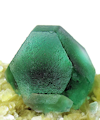| View previous topic :: View next topic |
| Author |
Message |
Jim Prentiss
Joined: 01 Dec 2009
Posts: 103
Location: Ohio



|
 Posted: Jun 06, 2010 07:19 Post subject: mineral bonding Posted: Jun 06, 2010 07:19 Post subject: mineral bonding |
|
|
Hello Everyone,
I have been doing some reading on bonding, and I am wondering if there is any hard and fast rule to detemine the type of bond each mineral has? How can you tell whether one is either ionic, covalent or combination?( I am fairly confident I can determine metallic). Or is there some refernece that mentions what they are in the discriptions?
Thanks All,
Jim Prentiss |
|
| Back to top |
|
 |
Pete Richards
Site Admin

Joined: 29 Dec 2008
Posts: 846
Location: Northeast Ohio



|
 Posted: Jun 06, 2010 07:52 Post subject: Re: mineral bonding Posted: Jun 06, 2010 07:52 Post subject: Re: mineral bonding |
|
|
I can't give a complete answer, but minerals don't necessarily only have one kind of bonding. In micas, for example, the sheets parallel to the cleavage are composed of inter-linked silicate tetrahedra (four oxygens surrounding a silicon atom) and other metal (e.g. aluminum, iron, magnesium) octahedra (six oxygens surrounding the metal) which have strong bonds, whereas the layers are connected via large cations such as potassium via very weak bonds. This accounts for the ability of mica to be split into very thin sheets.
There's a lot of simplification in this reply - look up the mica group in any modern mineralogy text for a more complete treatment.
Dennen's Principles of Mineralogy indicates that in general elements that are located toward the left and right edges of the periodic table tend toward ionic bonding, while those nearer the middle tend toward covalent bonding. Bonding may be intermediate between covalent and ionic. Halite has ionic bonding, diamond has covalent bonding. Bonding in corundum is more ionic than covalent, but not completely ionic; bonding in sphalerite is more covalent than ionic. Many silicates are intermediate between covalent and ionic.
_________________
Collecting and studying crystals with interesting habits, twinning, and epitaxy |
|
| Back to top |
|
 |
Carles Millan
Site Admin

Joined: 05 May 2007
Posts: 1537
Location: Catalonia



|
 Posted: Jun 06, 2010 08:02 Post subject: Re: mineral bonding Posted: Jun 06, 2010 08:02 Post subject: Re: mineral bonding |
|
|
It depends on the difference between the electronegativity of the two atoms that form the bond. Halite bonds are mainly ionic. Quartz's are rather covalent. Diamond is completely covalent. However, in many sulfides, like galena and pyrite, there is a metallic bond, which means that the electrons are arranged in a kind of large cloud and explains why such minerals are never transparent. Native gold is, of course, completely metallic.
For more info about electronegativy values just google "electronegativity table", or search the Wikipedia. |
|
| Back to top |
|
 |
Jim Prentiss
Joined: 01 Dec 2009
Posts: 103
Location: Ohio



|
 Posted: Jun 08, 2010 12:57 Post subject: Re: mineral bonding Posted: Jun 08, 2010 12:57 Post subject: Re: mineral bonding |
|
|
Thanks Gentlemen,
I am going to take a look at the periodic table.
Would it be safe to assume that the majority of ionic bonds are simple compounds?
Thanks again,
Jim Prentiss |
|
| Back to top |
|
 |
|




